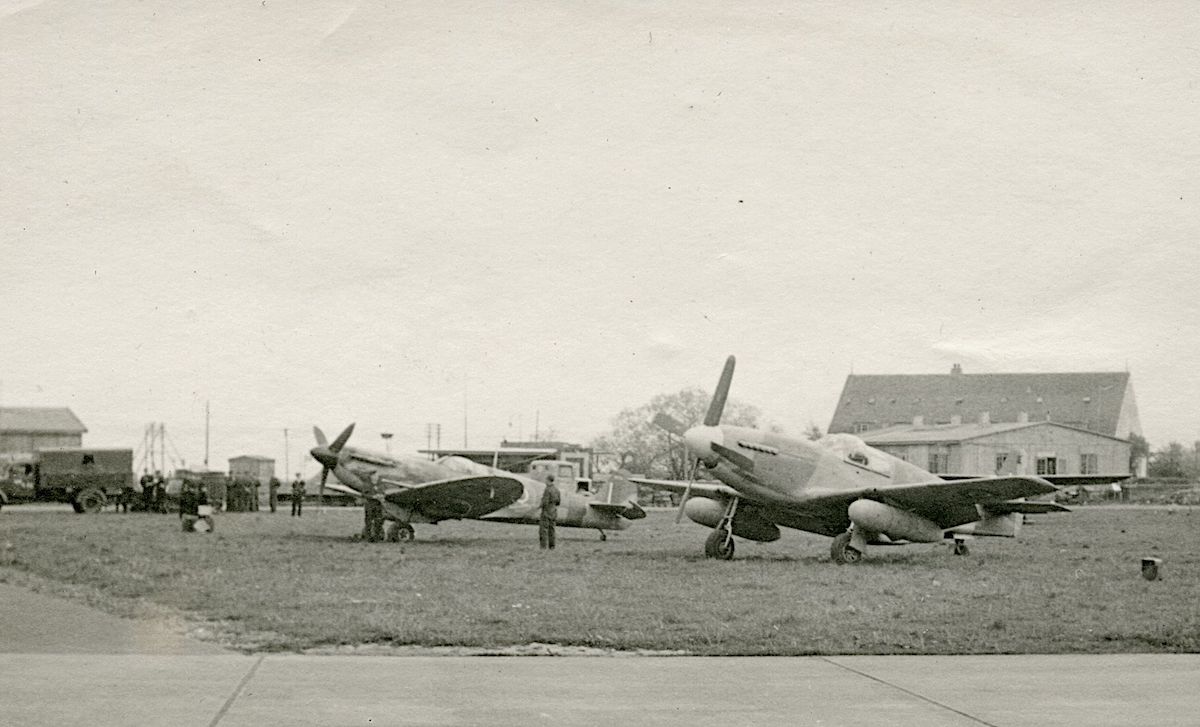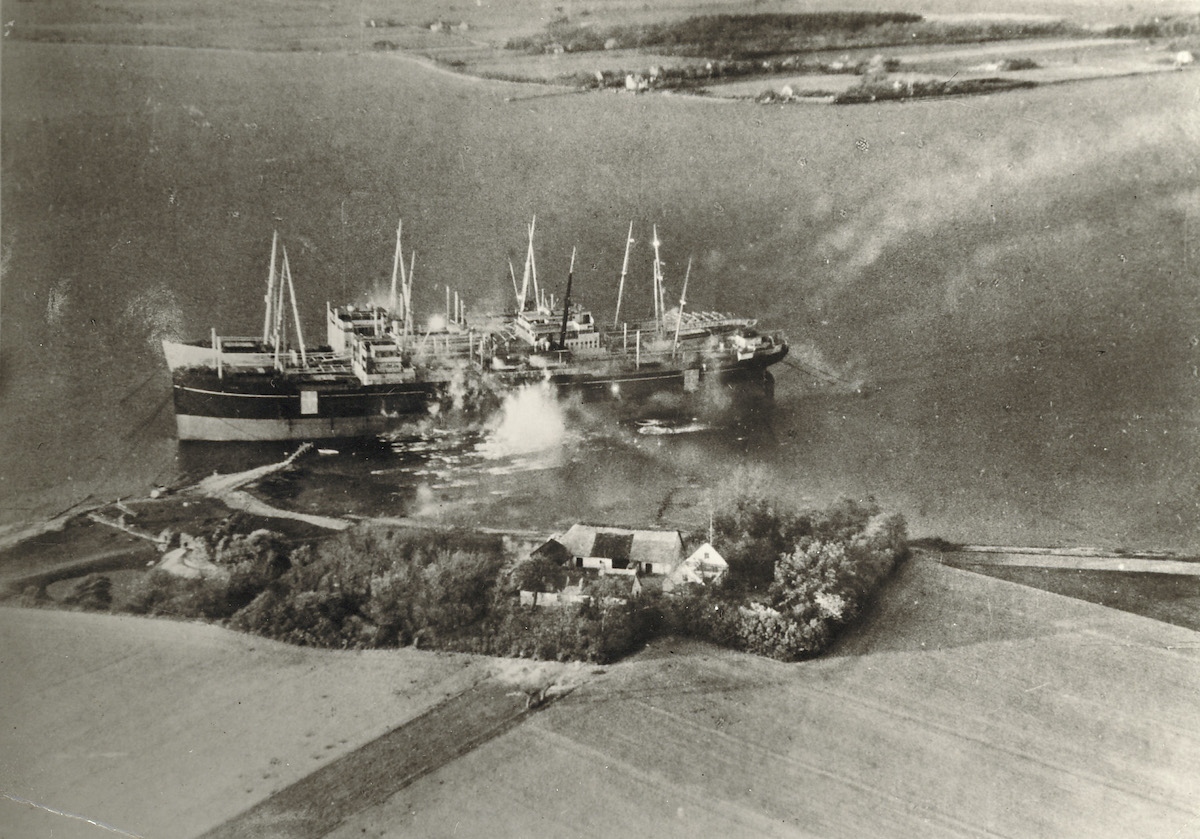‘So the war hasn’t finished after all!’
Article
As April turned into May in 1945, events suggested that the war in Europe would soon end. At this point, the anti-shipping attacks by Coastal Command and 2nd Tactical Air Force in Danish waters reached a climax. Wg Cdr Kaj Birksted and Lt Kjeld Rønhof was part of the escort, when the Strike Wings attacked on 3 May 1945. They both flew their last operations of the war on this day.
Coastal Command repositioned its strike wings on 1 May 1945 in preparation for attacks on shipping trying to escape to Norway trough the Kiel Bay and Kattegat. The Dallachy Wing (Beaufighter) in 18 Group moved from Scotland to stations in Norfolk, where it joined 16 Group’s North Coates Strike Wing. In the last days of the war, the wings used the advance base B.86 Helmond for refueling to increase the range. At the same time, Typhoons from 2TAF operating from bases in north Germany joined the anti-shipping operations. Approximately 40 pct. of the enemy vessels sunk (in tonnage) in the area in 1945 by Royal Air Force was sunk during from 1-4 May 1945.[1] This was the climax of the anti-shipping war over Danish waters.
Long-range fighter escort
The range of the Mustang fighter allowed the strike wings to be escorted all the way on these operations. Two Danish pilots flew escorts in early May. Wg Cdr Kaj Birksted DSO DFC had been appointed Wing Leader of the ‘B’ Wing at RAF Station Bentwaters on 16 March 1945. The squadrons of this wing—118, 129 (Mysore) and 165 (Ceylon) Squadrons—operated the Mustang III. Another fighter pilot—Lt Kjeld Rønhof—had been posted to 19 Squadron as Flight Commander at Peterhead in Scotland only days before, on 25 April 1945. He had not flown operationally since 7 October 1944, when he had been injured. He flew the Mustang IV for the first time on 26 April 1945.

Birksted and the Bentwaters Wing
Weather had prevented the Bentwaters Wing from operations since 25 April 1945, when they escorted 250 Lancasters bombing Berchtesgarden. During the operation the formation was attacked by Me 262s near Hamburg, and a single Me 163 was also observed by Birksted. The weather had prevented operational flying since then. The operational record book entry for 3 May 1945 reads
So the war hasn’t finished after all! Lt. Col. Birksted led 165 and 118 Squadrons to escort 27 Coastal Command Beaufighters from the North Coast across (and what a long way across) the North Sea and Denmark, to give a great belting to any shipping they might find in the Great Belt. They found shipping alright; so much of it that the Beaufighter expended all their rockets before they had run out of targets. Admiral Doughnuts must be getting that sinking feeling.[2]
In fact Birksted led a formation of twenty-two Mustangs from 165 and 118 Squadrons in an escort of twenty-nine Beaufighters in his last operation of the war. Thirty aircraft of the North Coates Strike Wing took off at 2.25 p.m.took off—seventeen from 254 Squadron armed with cannons only and thirteen from 236 Squadron armed with cannons and rocket projectiles—but one Beaufighter had to abort the mission early.[3]
The mission was to attack shipping in Danish waters—earlier in the day, large numbers of ships had been reported sailing north through the Great Belt. The Mustangs met the formation over North Coates and set out to cross the North Sea. The formation was to patrol the Great Belt for enemy vessels, starting from north-east of the island of Samsø and continuing to a point south of Langeland. As the formation was flying east of Samsø at 5.01 p.m., numerous vessels of all descriptions were observed and attacked. According to the crew reports, for the next half hour the formation attacked twenty-six vessels, including a fully surfaced U-boat (probably U2524). Having carried out the attack, the Beaufighters landed at B.86 Helmond in Holland, while Birksted and the rest of the escort landed at B.90 Kleine Brogel in Belgium. The Mustangs returned to Bentwaters the following day.
Birksted remained at the wing until the end of the May, leaving on the 31st to take up a staff appointment at the Royal Norwegian Air Force Headquarters in London.[4]
Rønhof's first and only Mustang operation
'At the very moment I saw the map in the briefing room, I thought, this is to good to be true,’ Rønhof wrote in his diary.[5] The briefing for what was to be his last operation of the war started at 14.45 hours at RAF Peterhead in Scotland; The operation would take him from Scotland over the North Sea, crossing the Danish coast at Ringkøbing. Then the force would cross Jutland, turn south at the island of Samsø, though the Great Belt to Langeland. The operation was postponed and the route changed. He was going to see Denmark for the first time since leaving on 9 April 1940.
Six Mustang IVs from 19 Squadron and twelve Mustang IVs from 234 Squadron was to provide escort to forty-eight Mosquitoes of Banff Strike Wing (143, 235, 248, 333 (N) and 404 Squadrons) on a shipping-strike in the Great Belt from Kattegat and further south. Rønhof was airborne from Peterhead at 16.40 p.m. in Mustang IV KH867/QV-S—in[6] its natural metal finish.[7] The rendezvous point was over the airfield. For the next two hours all he saw was the waves below in the Northern sea. Then, suddenly, the Danish coast appeared in the horizon. The force rose to a height of 2,000 ft, passed the dunes near Ringkøbing and flew above the heath as the encountered a heavy rainstorm. They managed to get through without problems and passed the eastern coast of Jutland at Vejle, more southernly than planned. Passing Endelave and Samsø, Rønhof was able to see Knudshoved in the Great Belt. They were flying at zero feet passing a number of friendly ships. Suddenly, they were notified about a group of aircraft, also flying at low level coming towards them from south. The aircraft turned out to be friendly.
The formation saw no significant shipping. At one point, the Mosquitoes were about to attack a Danish ship, but, it the last moment, the Mosquitos realized that it was a Danish ship and aborted the attack. Rønhof had realized from the funnel markings, that the ship belonged to the Danish shipping company DFDS, and had looked in horror as the Mosquitos had prepared to attack. The operation was called off because of the bad weather, and they returned to base where they landed at 21.10 hours.[8]
This was Rønhof’s last operation during the war. The next morning, he learned from the Danish newspaper in London, Frit Danmark, that his brother, Bengt Rønhof, had been shot by the Germans. He had been detailed for another operation over Danish waters that morning, but was grounded by his commanding officer because of the sad news.[9]

Endnotes
[1] Roskill, War at Sea 1939-45: Volume III Part 2 The Offensive 1st June 1944-14th August 1945.
[2] NA: AIR 28/57.
[3] NA: AIR 271449; AIR 27/1516.
[4] NA: AIR 26/57.
[5] Diary, the Rønhof family collection.
[6] NA: AIR 27/254; AIR 27/1440.
[7] Diary, the Rønhof family collection.
[8] NA: AIR 27/254.
[9] Rønhof (1996). Vi fløj for friheden, p. 182.